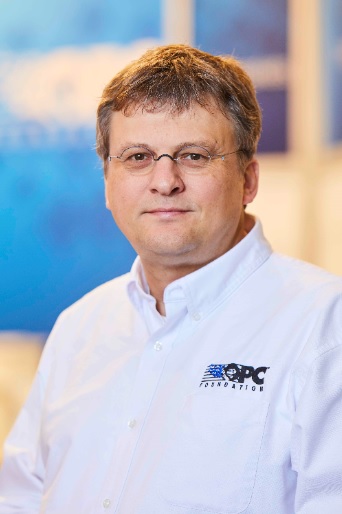The OPC Foundation will continue to expand its role as the “United Nations of Automation” – the foundation where different organizations work together to standardize and harmonize.

The basic idea for the establishment of the OPC Foundation in 1996 was to create a communication standard based on the Microsoft COM/DCOM architecture of that time – “OLE for Process-Control” was thus established as the de-facto standard “of the last mile” for controllers.
The new architecture OPC Unified Architecture “OPC UA” is much more than just an operating system independent, neutral platform for data communication: OPC UA is the “Lego” building block for the standardization of data and interfaces and their secure exchange scaling from the sensor to the cloud (and back) – including discovery of devices, onboarding and more. The milestones consisted of the definition from 2003 to 2006, the validation of the technology and publication of the core functionality in 2008, followed by the international standardization as IEC 62541 standard in 2011. First products were available on the market in 2007 and these are stably addressable via today’s OPC UA clients – there was no break in the technology.
OPC UA will probably never be “complete” as the framework is constantly being expanded: In 2018, the first major expansion to the existing client/server communication model with a publish/subscribe communication model (PubSub) was released – in addition to other deployment scenarios such as distribution in broadcast, integration in smaller devices, communication to the cloud via MQTT or AMQP, this was also an important step as preparation for use at the field level: PubSub initially enables a high-performance controller-to-controller communication in order to connect devices of different eco-systems horizontally with a neutral approach.
“Holistic approach blurs the boundaries of process and factory automation”
The OPC Foundation Initiative “Field Level Communication” (FLC), newly founded in November 2018, has larger goals than the reduction to “OPC UA with TSN for the factory”. The harmonization of requirements from process and factory automation will result in common device services: Device management, firmware updates, OOE data, power management, MES services or even common data types will blur the boundaries of process and factory automation in device handling – of course, special technological requirements will remain. The work is already advanced, OPC Safety and OPC Motion are currently being developed and can be used in the future – with an optionally switchable TSN if determinism is required.
The OPC Foundation has joined the Ethernet APL initiative: In process automation “OPC UA over APL/SPE” will be established as the successor of the current de facto Hart standard and will gradually be installed as a new solution – initially only as a “second diagnostic channel” (NOA channel) but increasingly also in the first data channel.
In the long term of two decades, the number of fieldbus systems will be reduced to a maximum of the “Big 5” including OPC UA. Many products of the future will be hybrid products that will have integrated the OPC UA solution in addition to the established technology – like cars that have electric drives for different scenarios in addition to conventional combustion engines.
The trend towards data and interfaces being standardized as far as technically possible at the data source will continue – if feasible directly in the device and sensor: A flow meter will provide standardized “OPC UA flow measurement data” as soon as the APL cable is plugged in. Otherwise, other transmission techniques will remain for special scenarios, to become interoperable via OPC UA gateway at the appropriate point.
However, I am concerned about the large number of “user organizations” that have been started, often with a promising “Open” in their name. More and more new organizations often take care of the same tasks. The key to the future is not to initiate new organizations – but the much closer cooperation of existing organizations. Just as the climate challenge cannot be solved by individual states, but only by the community of states – so it is in automation.
The OPC Foundation currtly cooperates with other organizations in more than 52 initiatives – as “United Nations of Automation” – in order to fulfil the vision of a Plug&Produce solution with an open, uniform, secure and standards-based IIoT communication solution – from the sensor through all levels to the cloud with all the requirements of industrial automation. The challenge of the OPC Foundation in the next decade is to channel the global “OPC UA movement” and structure the many activities. The goal is a plug&play of standardized information.






































